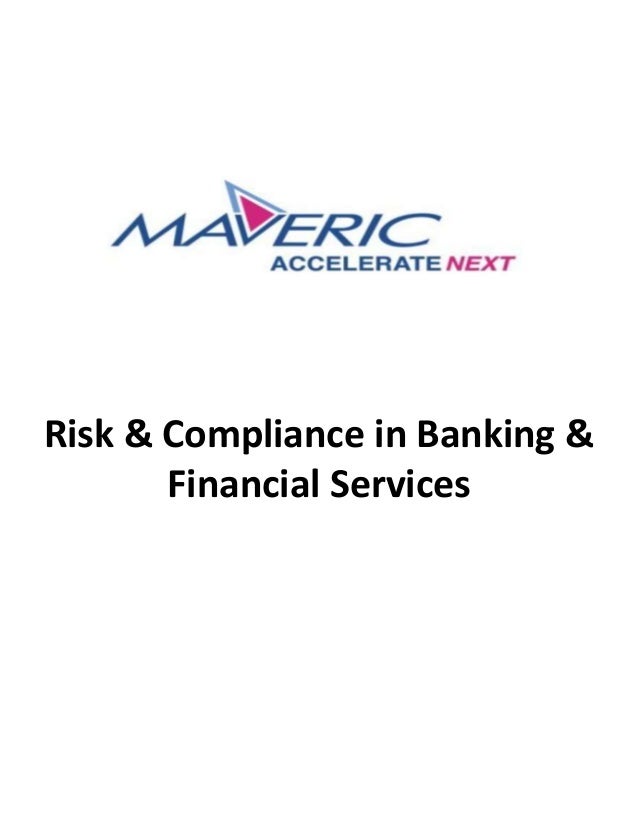
Risk & Compliance in Banking & Financial Services.pptx
- 1. Risk & Compliance in Banking & Financial Services
- 2. The current climate (especially post-COVID) is creating a new challenge for bank leaders. The new reality of compliance is putting enhanced pressure on what is a must-do and what is a good-to-do? After this crucial point, secondary considerations arise – How do organizations decide the shape and size of their compliance departments? What about the associated risk processes and compliance technology? Ultimately the focus on risk and compliance pivots around the extent of financial penalties and reputational risks to which the banks are responsible.
- 3. Risk and Compliance Mandate for Banking and Financial Services Leading banks understand that there must be a clear assignment of responsibilities and accountabilities that prevents role confusions, activity duplications, and clarity over risk ownership. To that extent, there is an increased focus on redefining the compliance function mandate, which is listed under. •Monitoring whether the business regularly meets regulatory obligations. •Independent oversight over all aspects of business activity. •Creating first, second and third lines of defense for regulatory changes. •Assessing the continual impacts of changing risk profiles as businesses evolve. •Management of conflicts of interests and issues of whistleblowing. •Design, document, and disseminate compliance frameworks. •Provide regulatory risk training In the backdrop of these aspects, leading banks are experimenting with new compliance frameworks and cadences. Below we discuss the major components as applicable to banks.
- 4. Risk assessment programs– mapping defined laws and regulations that apply to various lines of business and establishing a consistent risk language, thresholds, and tolerances. Compliance technology– Document tech platforms used by compliance and leverage automation possibilities for risk assessment, testing, reporting, and issue management. Policies and procedures– Develop formalized compliance and risk policies, procedures, and controls documentation. After that, establish and socialize business operating principles. Compliance monitoring and testing– Agree on scope, frequency, and schedule for monitoring and testing. After that, align on corrective actions and remediation plans. Crucial components of a Bank’s regulatory compliance & risk management program.
- 5. Governance– Set and communicate the ‘culture of compliance’ by establishing clear roles and responsibilities. Then define governance processes and manage compliance risk committees. Regulatory interaction and coordination– Enterprise- wide rigor for risk examinations, determining communication protocols, and standard responses for regulator inquiries. Understanding the risk and compliance mandate and exploring the program components is prudent to check how technology is transforming the function. While these initiatives entail significant investments in time and money, the gains are noteworthy. Data is continually enhanced by automating and improving operational and reporting processes and simplifying and standardizing processes. This supports the development and adoption of AI models and superior- tech cadences.
- 6. 1.) Capacity Building Top banks are increasingly using technology to increase or enhance surveillance and monitoring activities. Use of Technology and Data – lessons from the future Additional investments in robust reporting allow compliance teams to focus quickly on specific risks and help them visualize the risk burden and the extent of reputational damage. 2.) Robotic Process Automation Automating existing manual processes (chatbots for queries and, say, conflict of interest’s situations) have longer-term efficiency gains, not to mention the number of personnel freed for other key deliverables. Next, investments in AI software (along with the advances in Natural language processing, ML, and Semantic Analytics) cut down the sheer volume of noncomplex and non-advisory compliance-related questions.
- 7. 3.) Responding to Regulatory change Continually scanning and deciphering new regulatory updates is complex and labor-intensive. Leading banks create automation libraries of a vast inventory of regulations, laws, and obligations gathered from global sources. The teams then exploit AI tools to match and contrast the proposed or incoming rule changes. Such quick impact analysis yields significant efficiency gains. 4.) Preventing Financial Crimes Every other month, financial crime is being foiled through data mining and advanced analytics. With advanced eDiscovery tools today, compliance teams monitor communications and identify word patterns and sentiment by splits (values across wholesale and retail firms). After that, creative solutions anchored by data and technology allow more excellent coverage, faster feedback, improved effectiveness, and lower costs. 5.) Innovating training approaches With fast advancements in Ed-Tech sectors, risk and compliance teams employ agile training approaches. By designing and delivering digital micro-learning modules with robust assessment practices, top banks can disseminate a much better understanding of regulatory requirements across their lines of business.
- 8. Conclusion Successful banking teams ensure their task automation levels are aligned with their compliance strategy and the organization’s risk culture and tolerance. Moreover, identifying compliance processes, data, and analytics allows for an overall risk assessment. In the final assessment, these steps help banks set priorities for measuring benefits and limitations in line with their budgets, resourcing, timelines, governance structure, change management approaches, and communication strategy and training plans. What does the future hold for risk and compliance teams in banks?
- 9. Contact Us Reach us: https://maveric-systems.com/reach-us/ Website: https://maveric-systems.com/ Original Source: https://maveric-systems.com/blog/risk-compliance- in-banking-financial-services/ Facebook: https://www.facebook.com/mavericsystemsltd/ Twitter: https://twitter.com/mavericsystems YouTube: https://www.youtube.com/c/mavericsystemsltd LinkedIn: https://www.linkedin.com/company/maveric- systems-limited/ Social Media
